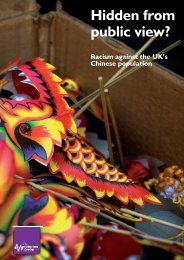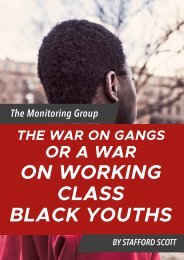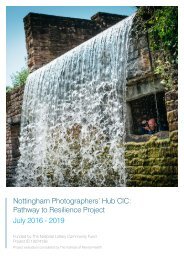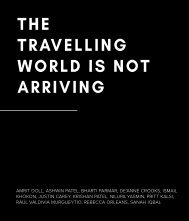Coming of Age : 1976 and the Road to Anti-Racism
Coming of Age : 1976 and the Road to Anti-Racism by Jagdish Patel and Suresh Grover
Coming of Age : 1976 and the Road to Anti-Racism
by Jagdish Patel and Suresh Grover
Create successful ePaper yourself
Turn your PDF publications into a flip-book with our unique Google optimized e-Paper software.
Sisters began. These two organisations have been challenging both racism from white<br />
communities, but also issues around sexism, patriarchy <strong>and</strong> religious fundamentalism<br />
within our own communities. As we shall see, progressive political <strong>and</strong> cultural change<br />
necessitates that <strong>the</strong>se issues are tackled in t<strong>and</strong>em with <strong>the</strong> struggle against racism.<br />
We found it difficult <strong>to</strong> talk about <strong>the</strong> events <strong>of</strong> <strong>1976</strong>, without examining <strong>and</strong> charting <strong>the</strong><br />
journey before this year. Afterall, each generation continues <strong>the</strong> s<strong>to</strong>ry from where <strong>the</strong>ir<br />
elders left, <strong>and</strong> in part 1 <strong>of</strong> this book we have tried <strong>to</strong> chart <strong>the</strong> s<strong>to</strong>ry from <strong>the</strong> racism in<br />
1919 through <strong>to</strong> <strong>1976</strong>. Throughout <strong>the</strong> period from 1919 <strong>to</strong> <strong>1976</strong> black <strong>and</strong> asian communities<br />
<strong>of</strong>ten faced a onslaught on violent racism, enduring attacks upon ei<strong>the</strong>r <strong>the</strong>ir person<br />
or <strong>the</strong>ir property, <strong>and</strong> yet we now teach that ‘British values’ equates with <strong>to</strong>lerance <strong>and</strong><br />
harmony. Jacqueline Jenkinson, in <strong>the</strong> opening chapter, examines <strong>the</strong> circumstances which<br />
led <strong>to</strong> <strong>the</strong> 1919 race riots <strong>and</strong> she begins <strong>to</strong> unpick how ‘British values’ play out when <strong>the</strong>re<br />
is a deep crisis in <strong>the</strong> country. In <strong>1976</strong> <strong>the</strong> journalist Paul Foot argued that “race hate <strong>and</strong><br />
race violence does not rise <strong>and</strong> fall according <strong>to</strong> <strong>the</strong> numbers <strong>of</strong> immigrants coming in<strong>to</strong><br />
Britain. It rises <strong>and</strong> falls <strong>to</strong> <strong>the</strong> extent <strong>to</strong> which people’s prejudices are inflamed <strong>and</strong> made<br />
respectable by politicians <strong>and</strong> newspapers.’ (’What <strong>the</strong> Papers Say’, Granada TV 4 June <strong>1976</strong>).<br />
In post Brexit Britain, do we think that our politicians <strong>and</strong> press have learnt from <strong>the</strong> past?<br />
In ‘Racialised Outsiders’, Satnam Virdee argued that after <strong>the</strong> defeat <strong>of</strong> <strong>the</strong> radical Chartist<br />
movement in <strong>the</strong> mid-nineteenth century, racializing nationalism began <strong>to</strong> permeate <strong>the</strong><br />
working class imagination. This was carefully constructed through Britain’s policy in art <strong>and</strong><br />
culture, as much as politics <strong>and</strong> economics. We only have <strong>to</strong> walk around our own <strong>to</strong>wns <strong>and</strong><br />
look at <strong>the</strong> statues, look in <strong>the</strong> museums <strong>and</strong> galleries <strong>to</strong> see evidence <strong>of</strong> this even <strong>to</strong>day.<br />
It was Martin Lu<strong>the</strong>r King who reminded us form a prison cell in a Birmingham jail<br />
that, “In a real sense all life is inter-related. All men are caught in an inescapable<br />
network <strong>of</strong> mutuality, tied in a single garment <strong>of</strong> destiny. Whatever affects one<br />
directly, affects all indirectly. I can never be what I ought <strong>to</strong> be until you are what you<br />
ought <strong>to</strong> be, <strong>and</strong> you can never be what you ought <strong>to</strong> be until I am what I ought <strong>to</strong> be...<br />
This is <strong>the</strong> inter-related structure <strong>of</strong> reality.” Yet, our structures <strong>of</strong><br />
reality is dis<strong>to</strong>rted, since we have been woven out <strong>of</strong> British his<strong>to</strong>rical narrative.<br />
As we write, <strong>the</strong>re are protests taking place near <strong>the</strong> statue <strong>of</strong> <strong>the</strong> Confederate General<br />
Robert E Lee in Emancipation Park, Charlottesville, Virginia, USA. The protests started<br />
after <strong>the</strong> local city council voted <strong>to</strong> remove <strong>the</strong> statue <strong>and</strong> change <strong>the</strong> name <strong>of</strong> <strong>the</strong> space<br />
from Lee Park <strong>to</strong> Emancipation Park, sparking protests from white nationalists, neo-Nazis,<br />
<strong>the</strong> Ku Klux Klan <strong>and</strong> members <strong>of</strong> <strong>the</strong> ‘alt-right’. During <strong>the</strong> protests Thirty-four<br />
people were injured in clashes <strong>and</strong> one person, Hea<strong>the</strong>r Heyer, was killed, when a Nazi sympathizer<br />
plowed his car in<strong>to</strong> a crowd <strong>of</strong> counter-protesters. Our cities <strong>and</strong> <strong>to</strong>wn are also lit-<br />
<strong>Coming</strong> <strong>of</strong> <strong>Age</strong> | 7<br />
<strong>Coming</strong> <strong>of</strong> <strong>Age</strong> Final version 16.10.indd 7 17/10/2017 12:06







